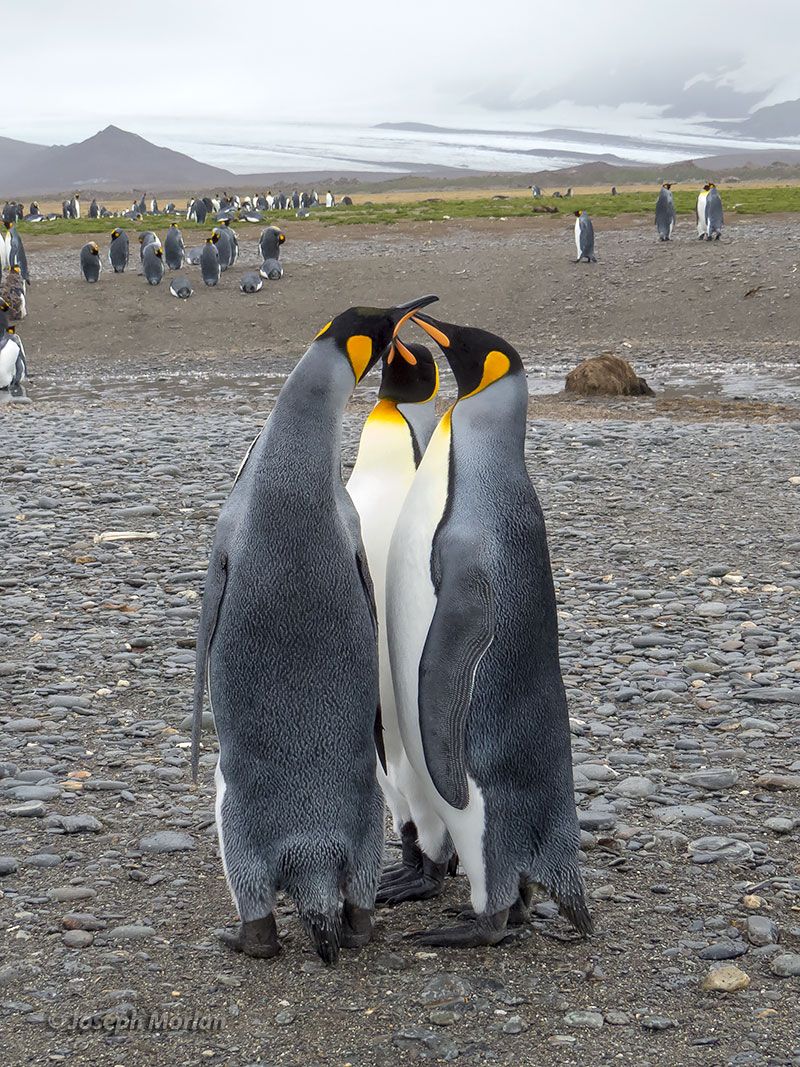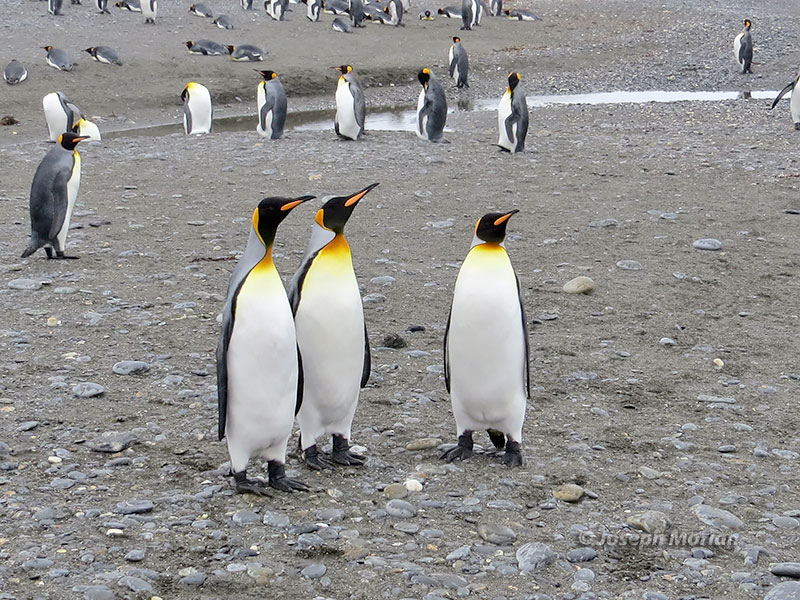

Scenic glaciers are in the distance. Triads like this form when two displaying males are joined by a female who
becomes part of the commotion. Sky-pointing and tooting like a kazoo are all part of these rituals. Males are slightly
larger than females. In the top photo the males are in front; the shorter female is in back. In the bottom photo,
the female is to the right.
These are adults. Immatures have paler ear patches. The pigment which produces the distinct orange coloration in the adults was only recently discovered. It is known as "spheniscin" and is apparently unique to penguins. Standing at over 3 ft. this is the world's second largest penguin. Only the Emperor Penguin (A. forsteri) is larger.
Clements et al. (2017) and Martinez et al. (2018) recognize two poorly defined races. Mathews (2011) described A. p. halli stating it "differs in its lighter coloration above and less blue on the under-side of the flipper, from the typical form, while the feathers of the inside on the tarsus are white; in the typical subspecies the feathers of the tarsus are blue all round, forming a collar." Subsequent analyses by Murphy (1936), Stonehouse (1960) and others show that this race cannot be upheld and the King Penguin is considered monotypic by Gill, F & D Donsker (2018); Dickinson, EC (2014); Blake (1977); and Marchant, S. & P.J. Higgins (1990).. However A. p. halli was accepted by Peters (1931). Martinez et al. (2018) state that it averages smaller than nominate, a difference not discussed or noted in the original description. They make no note of the supposed diagnostic features proposed by Matthews. If A. p. halli is valid, birds breeding on South Georgia are nominate as that is the type locality for the species.
King Penguins are highly social and gregarious. The colonies seem to divide into three distinct social components.
- Breeders
- Meeters and Greeters
- Molting Birds.
The breeders are densely packed. The greeters are scattered around the periphery and show considerable interest
in human visitors often running up to greet us. The molting birds are antisocial, hunkering farthest from the core
and looking miserable. This species breeds twice every three years, so that may account for staggered social groups.
Canon PowerShot SX50 HS
Reference:
Blake, E. R. 1977. Manual of neotropical birds. Volume 1. University of Chicago Press, Chicago, Illinois.
Clements, J. F., T. S. Schulenberg, M. J. Iliff, D. Roberson, T. A. Fredericks, B. L. Sullivan, and C. L. Wood. 2017. The eBird/Clements checklist of birds of the world: v2017, with updates to August 2017. Downloaded from http://www.birds.cornell.edu/clementschecklist/download/
Clucas, Younger, Kao, Rogers, Handley, Miller, Jouventin, Nolan, Gharbi, Miller, Hart. 2016. Dispersal in the
sub-Antarctic: king penguins show remarkably little population genetic differentiation across their range. BMC
Evol. Biol., 16:211.
[open access]
Dickinson, EC, ed. 2014. The Howard and Moore Complete Checklist of the Birds of the World. 4th ed. Princeton: Princeton Univ. Press
Gill, F & D Donsker (Eds). 2018. IOC World Bird List (v8.1). doi : 10.14344/IOC.ML.8.1. Available at http://www.worldbirdnames.org/.
King Penguin (Aptenodytes patagonicus), In Neotropical Birds Online (T. S. Schulenberg, Editor). Cornell Lab of Ornithology, Ithaca, NY, USA. retrieved from Neotropical Birds Online: https://neotropical.birds.cornell.edu/Species-Account/nb/species/kinpen1
Marchant, S. & P.J. Higgins (eds) 1990. Handbook of Australian, New Zealand and Antarctic Birds. Volume 1: Ratites to Ducks. Oxford University Press, Melbourne
Martínez, I., Jutglar, F. & Garcia, E.F.J. (2018). King Penguin (Aptenodytes patagonicus). In: del Hoyo, J., Elliott, A., Sargatal, J., Christie, D.A. & de Juana, E. (eds.). Handbook of the Birds of the World Alive. Lynx Edicions, Barcelona. (retrieved from https://www.hbw.com/node/52456 on 27 May 2018).
Mathews G. M. 1911. The birds of Australia. London, UK: Witherby
Murphy, R.C. (1936) Oceanic Birds of South America. Am. Mus. Nat. Hist.
Peters, J. L. (1931) Checklist of Birds of the World. Vol. 1. Harvard, Univ. Press.
Stonehouse, B (1960). "The King Penguin Aptenodytes patagonicus of South Georgia I. Breeding behaviour and development". Falkland Islands Dependencies Survey Scientific Report. 23: 1–81.
Thomas, DB, McGoverin CM., McGraw KJ. James HF, Madden O. 2013. Vibrational spectroscopic analyses of unique yellow feather pigments (spheniscins) in penguins. Journal of the Royal Society [DOI: 10.1098/rsif.2012.1065]